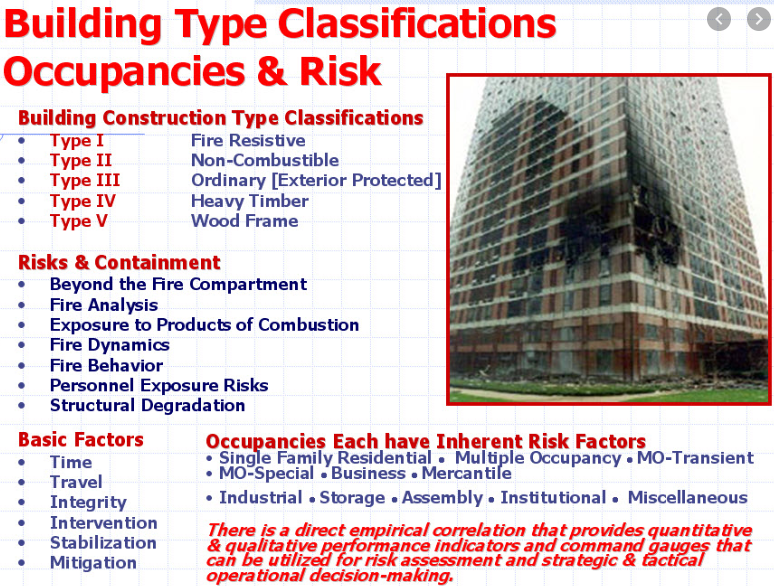This is about the minimum life safety requirement for building construction for Building and plants and their associated utility and offsite facilities.
The buildings shall be design and constructed in accordance with NFPA 101.
Every building shall be constructed, protected, arranged, equipped, maintained, and operated to avoid undue danger to the lives and safety of its occupants from fire, smoke, fumes, or resulting panic during the time period for escape from the building.
Each building means of egress shall be arranged and maintained to provide free and unobstructed egress from all parts of the building at all times. No lock or fastening device shall be installed to prevent the means of escape from inside each building.
Each exit shall be clearly visible, or the route to reach each exit shall be conspicuously indicated in a way that every occupant shall easily be aware of the direction of escape from any point in the building. Location of a safe place or place of refuge shall be clearly posted at places where they will be readily seen by anyone entering or leaving the building. Two remotely located means of egress shall be arranged to minimize the possibility that both exits may be rendered impassable by the same emergency condition.
Means of egress, exits, stairs, door and window assemblies, rails, emergency lighting, fire walls, fire extinguishing system, fire protection systems, fire alarm and detection systems, and other items for life safety shall be designed and constructed in accordance with the NFPA.

Building Construction and Occupancy Types | Buildings Fire Protection
High Risk Occupancy
High risk occupancy includes buildings that store, process or operate known high hazard materials that represent a high level concern for safety based on the potential for explosion from a flammable gas or liquid source, and materials that can be ignited under ambient conditions. Fire protection systems shall be used to limit the risk to personnel and to the building structure and contents, which shall include controls for shutdown of the processes; venting; and alarm notification.
Occupancy of this type would be mainly buildings and laboratories handling hazardous materials.
These buildings shall be protected with a combination of foam system, sprinkler system, standpipe system, deluge system, water spray system, or water mist system, all in accordance with NFPA 11, 13, 14, 15, and 750. These buildings shall also be monitored by a fire and gas detection system, reporting to the main fire and gas control panel located in the main control building, and annunciating the plant hazardous warning system.
Medium Risk – Manned Occupancy
Medium risk occupancy includes buildings that store or handle known low/medium hazard materials that represent a minimal level of concern for safety, based on materials that cannot be ignited under ambient conditions, but have to be moderately heated before ignition occurs. Fire protection systems shall be used to limit the risk to personnel and to the building structure and contents, which also shall include controls of materials transferred or stored, locking, venting and alarm notification.
Occupancy of this type would be mainly for maintenance shops and warehouse buildings.
These buildings shall be protected with a sprinkler system (see exceptions for maintenance shop below) designed for general or rack storage, standpipe/hose rack system, deluge system, and extinguishers, all in accordance with NFPA 10, 13, 14, 231 and 231C. These buildings shall also include manual fire alarm stations, sprinkler system devices monitored by the main fire and gas control panel, and local annunciation.
Low Risk – Manned Occupancy
Low risk occupancy includes buildings that do not store or handle any known type of hazardous material, which coincides with a low level concern for safety, based on surrounding materials that have to be pre-heated before ignition occurs. Fire protection and extinguishing systems shall be used to limit the risk to personnel and to the building structure and contents, which shall include shutdown of non-emergency circuits, HVAC shutdown, and alarm notification.
Occupancy of this type would be mainly for control buildings, compounding buildings, gate house, office and training buildings.
These buildings shall be protected with a sprinkler system (except the gate house) and extinguishers, or a clean agent (halon replacement) extinguishing system all in accordance with NFPA 10, 13 and 2001. In addition these buildings shall be monitored by a fire detection system, reporting to the main fire and gas control panel, which shall include monitoring of the sprinkler system devices and manual fire alarm stations, along with local annunciation.
Low Risk – Unmanned Occupancy
Low risk, unmanned occupancy includes buildings that are normally unoccupied, that have a low level concern for safety based on surrounding materials that must be pre-heated before ignition occurs, but otherwise has equipment that may contribute to the fire hazard based exposure of arching type devices.
Fire extinguishing systems shall be used in order to limit the risk to equipment and building structure, which shall include shutdown of non-emergency circuits, HVAC shutdown, and alarm notification.
Occupancy of this type would be mainly for the substations, sunshade buildings, and operator shelter buildings. extinguishing system (except the operator and sunshade buildings) and extinguishers all in accordance with NFPA 10 and 12. In addition these buildings.
These buildings shall be protected with a CO2 shall be monitored by a local fire extinguishing panel, which shall include local annunciation.